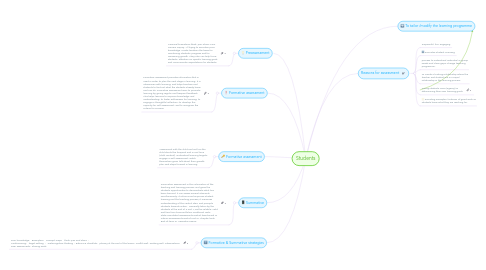Students
by Shane Ross

1. Summative
1.1. Summative assessment is the culmination of the teaching and learning process, and gives the students opportunities to demonstrate what has been learned. It can assess several elements simultaneously: it informs and improves student learning and the teaching process; it measures understanding of the central idea, and prompts students towards action. Generally taken by the students at the end of a unit. Must be reliable, valid and free from bias.Portfolios Traditional Tests State-mandated assessments District benchmark or interim assessments End-of-unit or -chapter tests End-of-term or -semester exams
2. Formative assessment
2.1. Assessment with the child and not too the child should be frequent and in real time (child centred). understand learning targets, engage in self assessment, watch themselves grow, talk about their growth, plan next steps forward in learning
3. Formative assessment
3.1. Formative assessment provides information that is used in order to plan the next stage in learning. It is interwoven with learning, and helps teachers and students to find out what the students already know and can do. Formative assessment aims to promote learning by giving regular and frequent feedback. This helps learners to improve knowledge and understanding, to foster enthusiasm for learning, to engage in thoughtful reflection, to develop the capacity for self-assessment, and to recognize the criteria for success.
4. Preassessment
4.1. Carousel brainstorm,think, pair, share, Four corners inquiry. All trying to ascertain prior knowledge. rovide teachers the basis for monitoring students' progress and for measuring growth. They also can help focus students' attention on specific learning goals and communicate expectations for students'
5. Formative & Summative strategies
5.1. Prior knowledge, Exemplars, concept maps, think, pair and share , Conferencing, target setting , metacognitive thinking , Rubrics & checklists plenary at the end of the lesson Graffiti wall- working wall, Observations Peer assessments Sharing work,
6. To tailor /modify the learning programme
7. Reasons for assessment
7.1. Purposeful, fun, engaging
7.2. Promotes student Learning
7.3. process to understand individual or group needs and close gaps, change teaching programme.
7.4. To create a trusting relationship where the teacher and student are in a equal relationship in the learning process
7.5. Giving students voice (agency) in determining their own learning goals.
7.6. Providing examples /criterion of good work so students know what they are reaching for.


